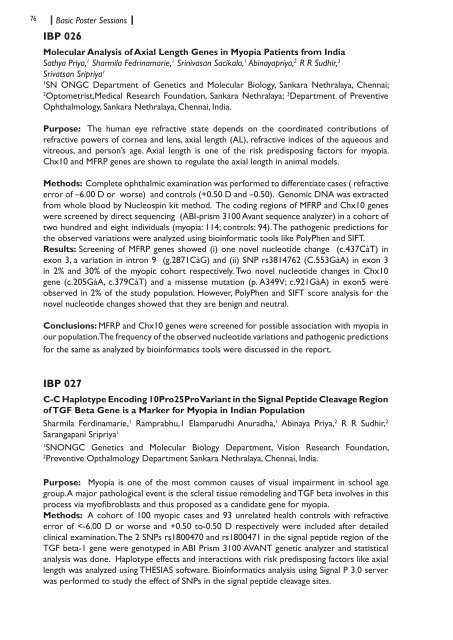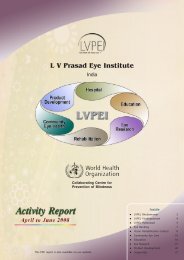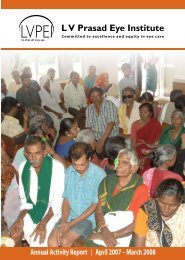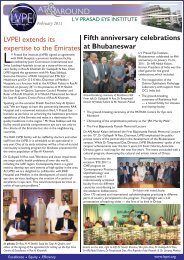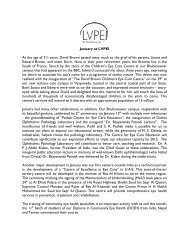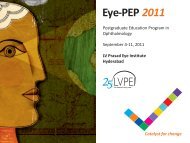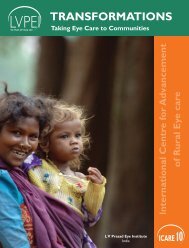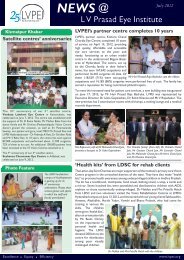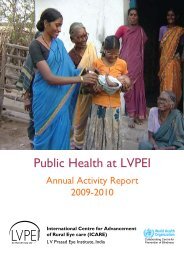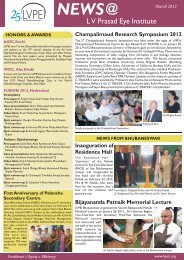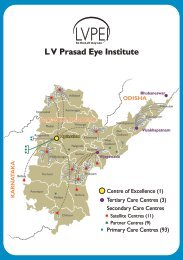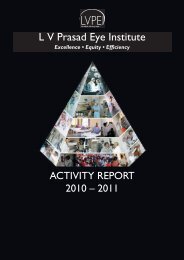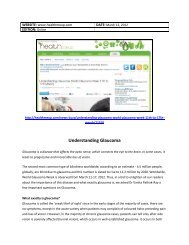IERG Abstracrt Book.indd - LV Prasad Eye Institute
IERG Abstracrt Book.indd - LV Prasad Eye Institute
IERG Abstracrt Book.indd - LV Prasad Eye Institute
Create successful ePaper yourself
Turn your PDF publications into a flip-book with our unique Google optimized e-Paper software.
76 Basic Poster SessionsIBP 026Molecular Analysis of Axial Length Genes in Myopia Patients from IndiaSathya Priya, 1 Sharmila Fedrinamarie, 1 Srinivasan Sacikala, 1 Abinayapriya, 2 R R Sudhir, 3Srivatsan Sripriya 11SN ONGC Department of Genetics and Molecular Biology, Sankara Nethralaya, Chennai;2Optometrist,Medical Research Foundation, Sankara Nethralaya; 3 Department of PreventiveOphthalmology, Sankara Nethralaya, Chennai, India.Purpose: The human eye refractive state depends on the coordinated contributions ofrefractive powers of cornea and lens, axial length (AL), refractive indices of the aqueous andvitreous, and person’s age. Axial length is one of the risk predisposing factors for myopia.Chx10 and MFRP genes are shown to regulate the axial length in animal models.Methods: Complete ophthalmic examination was performed to differentiate cases ( refractiveerror of –6.00 D or worse) and controls (+0.50 D and –0.50). Genomic DNA was extractedfrom whole blood by Nucleospin kit method. The coding regions of MFRP and Chx10 geneswere screened by direct sequencing (ABI-prism 3100 Avant sequence analyzer) in a cohort oftwo hundred and eight individuals (myopia: 114; controls: 94). The pathogenic predictions forthe observed variations were analyzed using bioinformatic tools like PolyPhen and SIFT.Results: Screening of MFRP genes showed (i) one novel nucleotide change (c.437CàT) inexon 3, a variation in intron 9 (g.2871CàG) and (ii) SNP rs3814762 (C.553GàA) in exon 3in 2% and 30% of the myopic cohort respectively. Two novel nucleotide changes in Chx10gene (c.205GàA, c.379CàT) and a missense mutation (p. A349V; c.921GàA) in exon5 wereobserved in 2% of the study population. However, PolyPhen and SIFT score analysis for thenovel nucleotide changes showed that they are benign and neutral.Conclusions: MFRP and Chx10 genes were screened for possible association with myopia inour population. The frequency of the observed nucleotide variations and pathogenic predictionsfor the same as analyzed by bioinformatics tools were discussed in the report.IBP 027C-C Haplotype Encoding 10Pro25Pro Variant in the Signal Peptide Cleavage Regionof TGF Beta Gene is a Marker for Myopia in Indian PopulationSharmila Ferdinamarie, 1 Ramprabhu,1 Elamparudhi Anuradha, 1 Abinaya Priya, 2 R R Sudhir, 2Sarangapani Sripriya 11SNONGC Genetics and Molecular Biology Department, Vision Research Foundation,2Preventive Opthalmology Department Sankara Nethralaya, Chennai, India.Purpose: Myopia is one of the most common causes of visual impairment in school agegroup. A major pathological event is the scleral tissue remodeling and TGF beta involves in thisprocess via myofibroblasts and thus proposed as a candidate gene for myopia.Methods: A cohort of 100 myopic cases and 93 unrelated health controls with refractiveerror of


